I. Introduction
● What is freediving
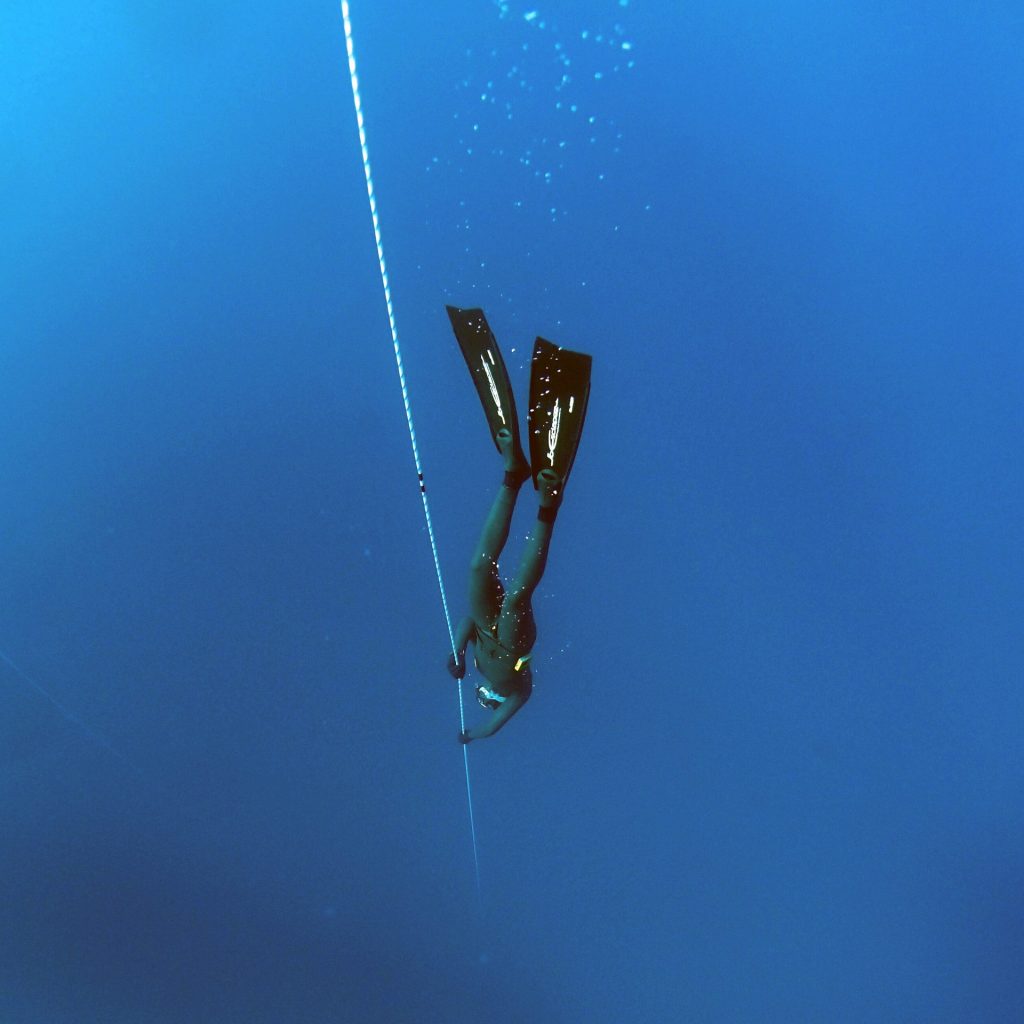
Freediving is a form of underwater diving where the diver holds their breath and does not use any breathing apparatus, such as scuba tanks. The diver relies on their own lung capacity and physical fitness to stay underwater for as long as possible. Freediving encompasses a wide range of activities and disciplines, including recreational diving, competitive diving, and spearfishing.
Recreational freediving is done for the purpose of leisure, relaxation, and enjoying the underwater environment. Competitive freediving is a sport that involves divers competing in various disciplines such as depth diving, time, and distance swimming. Spearfishing is the practice of hunting fish or other aquatic animals using a spear or a similar tool.
Freediving is a challenging sport that requires a high level of physical fitness and mental discipline. Divers must be able to hold their breath for extended periods of time, have good control over their breathing and heart rate, and possess the ability to equalize the pressure in their ears as they descend. It is essential that divers take the proper safety precautions, such as having a buddy and using a dive watch or computer to monitor the time and depth of their dives.
Freediving has a rich history, dating back to ancient civilizations, such as the Greek and Roman empires, where spearfishermen and pearl divers used breath-hold techniques to harvest seafood. In recent years, freediving has grown in popularity, with many people discovering the sport as a way to connect with nature, experience the thrill of adventure, and push their physical and mental limits.
● Explanation of the different disciplines of freediving
Freediving is a diverse sport that encompasses a variety of disciplines, each with its unique set of rules, techniques, and equipment. Some of the most popular disciplines in freediving are:
- Constant Weight (CWT):
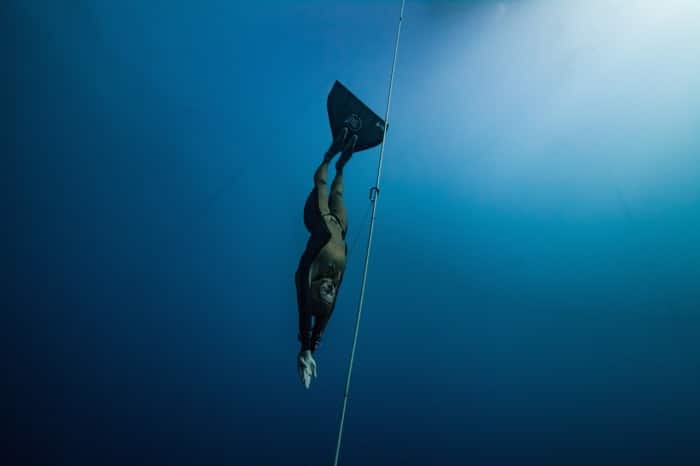
In this discipline, the diver descends and ascends using only their own strength, without pulling on the rope or using propulsion devices. The diver carries a weight that allows them to achieve neutral buoyancy at the surface, but not at depth. This discipline is considered one of the purest forms of freediving, as the diver is only using their own strength to reach depth and return to the surface.
- Free Immersion (FIM):
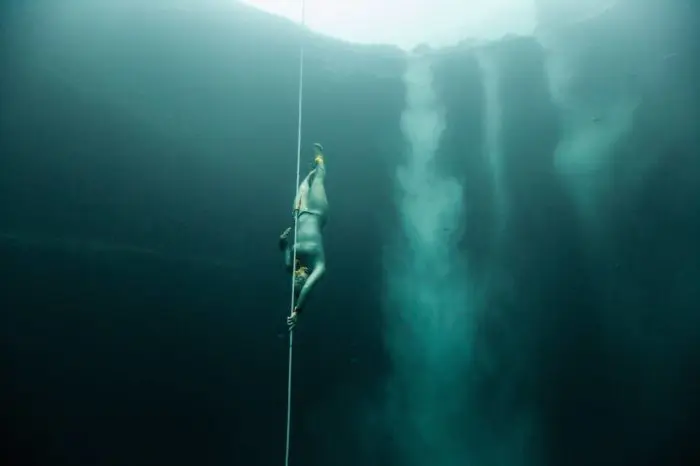
Similar to Constant Weight, but instead of using fins, the diver pulls themselves down and up the line using only their hands.
- Variable Weight (VWT):
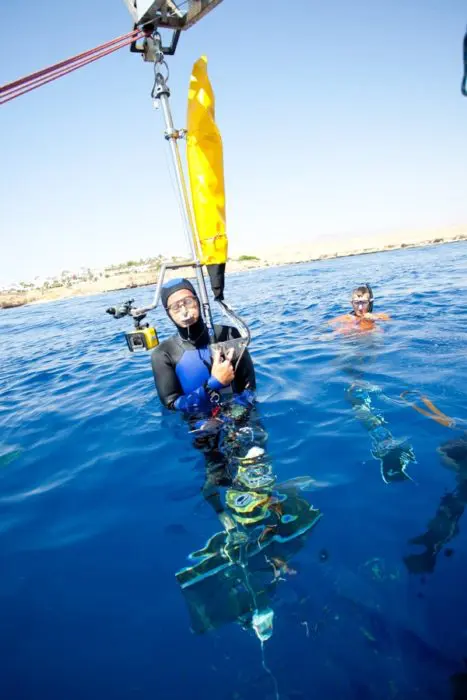
In this discipline, the diver descends on a weighted sled and ascends using a rope. This allows the diver to reach greater depths than they would be able to using only their own strength.
- No Limit (NL):

In this discipline, the diver descends on a weighted sled and ascends using a buoyancy device such as a lift bag. There are no limits to the amount of weight that can be used, which allows divers to reach extremely deep depths.
- Static Apnea (STA):
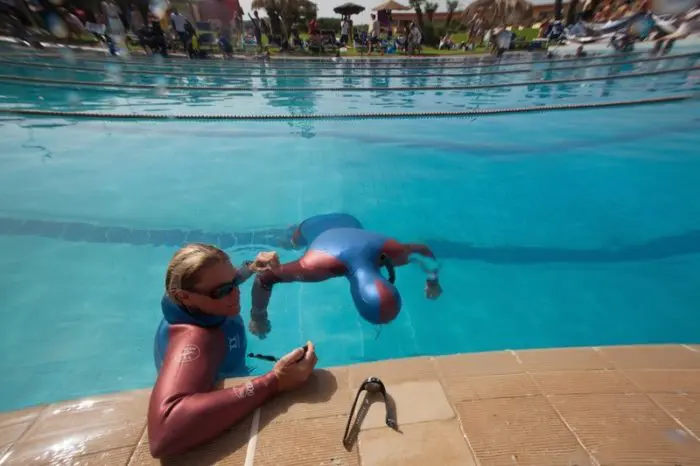
This discipline involves holding one’s breath for as long as possible while floating on the surface of the water.
- Dynamic Apnea (DYN):
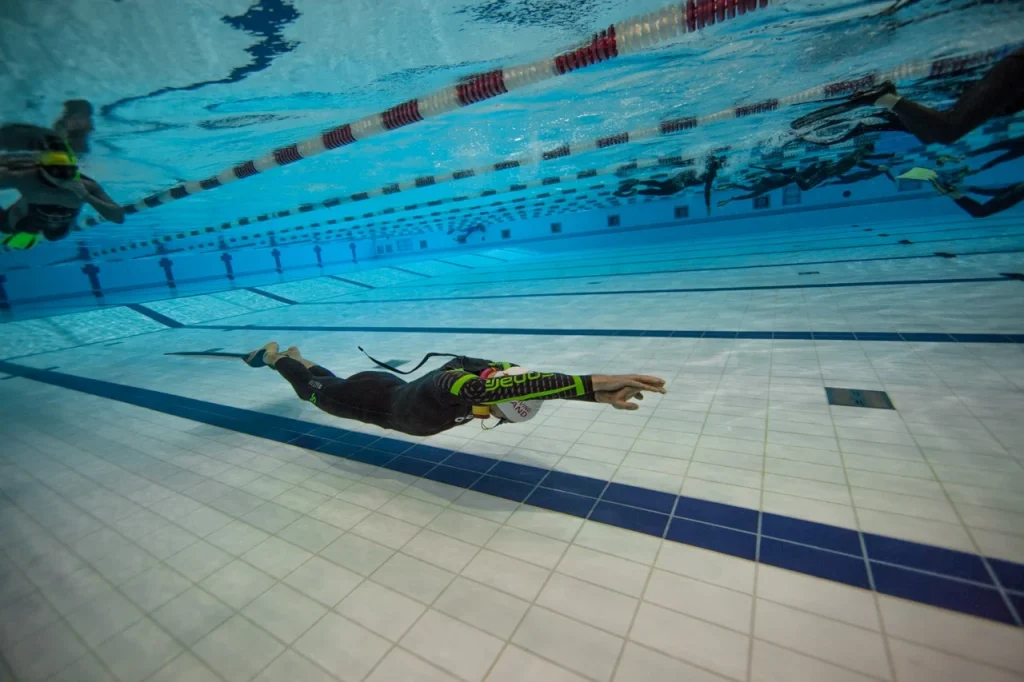
This discipline involves swimming horizontally under water for as far as possible on a single breath.
- Depth disciplines, Constant Weight Without Fins (CNF) and Free Immersion Without Fins (FIM) are also part of the freediving disciplines.
Each discipline requires a different set of skills and techniques, and divers must train specifically for each one. Understanding the different disciplines of freediving allows divers to choose the discipline that best suits their abilities and interests.
II. History of Freediving Records
● Earliest known depths achieved in freediving
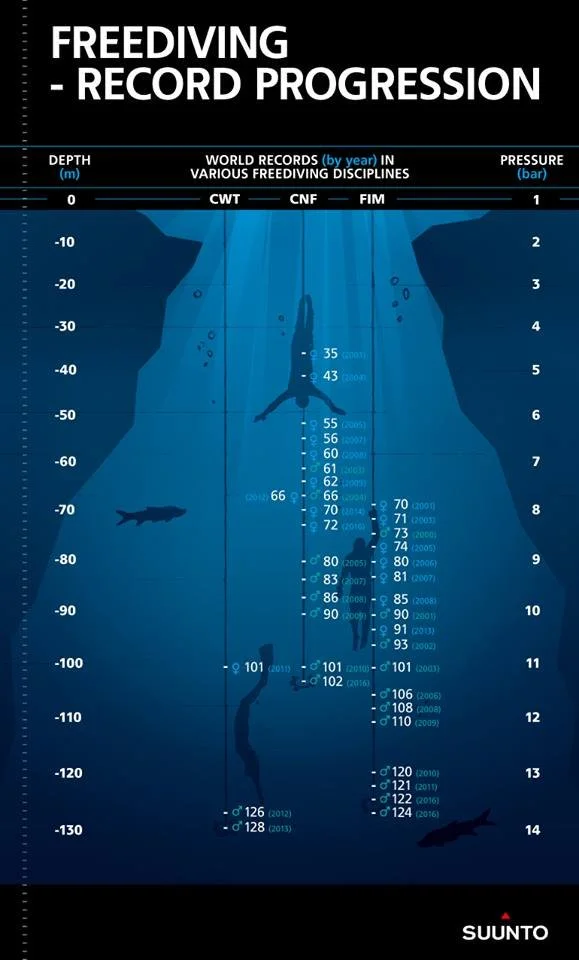
The earliest known records of deep freediving date back to the ancient civilizations of Greece and Rome, where pearl divers and spearfishermen used breath-hold techniques to harvest seafood from the depths. However, it wasn’t until the 20th century that freediving began to be recorded and organized as a sport.
One of the earliest recorded depths achieved in freediving was in 1926, when a Greek diver named Yiannis Kouros dove to a depth of 30 meters (98 feet) using the traditional technique of holding onto a heavy stone. This dive was recorded in the Guinness World Records as the deepest dive ever performed without the use of breathing apparatus.
In the 1940s, Jacques Mayol, a French diver, began to push the limits of depth and duration in freediving. Mayol was the first person to reach a depth of 100 meters (328 feet) on a single breath of air, a feat he accomplished in 1976.
However, the deepest dive ever achieved by freediver is 214 meters (702 ft) by Herbert Nitsch in 2007. He performed this dive in the No Limit discipline, using a weighted sled to reach the depth and a lift bag to ascend.
As technology and training methods have improved, divers have been able to reach greater depths and stay underwater for longer periods of time. Today, the deepest recorded dives in freediving are over 200 meters, and divers continue to push the boundaries of what is possible in this extreme sport.
● Evolution of freediving techniques and equipment
The evolution of freediving techniques and equipment has played a significant role in allowing divers to reach greater depths and stay underwater for longer periods of time.
In the early days of freediving, divers relied on simple equipment such as a weighted belt and a pair of fins. As the sport progressed, divers began to use wetsuits to protect against the cold and to provide buoyancy control. The development of fins with foot pockets and adjustable straps also allowed divers to generate more propulsion with less effort.
One of the most significant advancements in freediving equipment was the development of the diving mask, which allowed divers to see clearly underwater. The development of the diving regulator, which allows divers to breathe from a compressed air cylinder, also played a crucial role in the evolution of freediving.
As the sport progressed, divers began to use more specialized equipment such as monofins, which are large fins that cover both feet, allowing divers to swim faster and more efficiently. The use of diving weights, diving weights systems, diving suits, diving lamps and computers also increased.
Another important development in freediving was the use of training and safety protocols. Divers began to use tables and algorithms to calculate safe diving times and depths based on their lung capacity and experience level. They also began to use safety divers and surface markers to ensure the safety of the divers.
The evolution of freediving techniques and equipment has allowed divers to push the boundaries of what is possible in the sport, and continues to make it safer and more accessible to people of all skill levels.
● Impact of technology on the sport
Technology has had a significant impact on the sport of freediving, both in terms of equipment and training methods.
One of the most important technological advancements in freediving is the development of dive computers. These devices allow divers to monitor their depth, dive time, and other important information, such as their heart rate and oxygen levels. They also provide safety features such as decompression stop calculations, providing divers with crucial information to make safe and controlled dives.
Another important technology in freediving is the use of underwater communication systems which allow divers to communicate with their safety divers or instructors while underwater. This enables divers to receive important information and instructions, and to signal for help in case of an emergency.
In addition to equipment, technology has also played a role in the development of training methods for freediving. Online training programs and mobile applications have made it possible for divers to train and learn at their own pace, and to access a wide range of information and resources.
Furthermore, advancements in camera technology have also made it possible to capture stunning footage of freedivers in action, which has helped to increase the visibility and popularity of the sport.
Overall, technology has played a crucial role in the evolution of freediving, making it safer, more accessible, and more exciting to participate in.
III. Famous Freedivers and Their Records
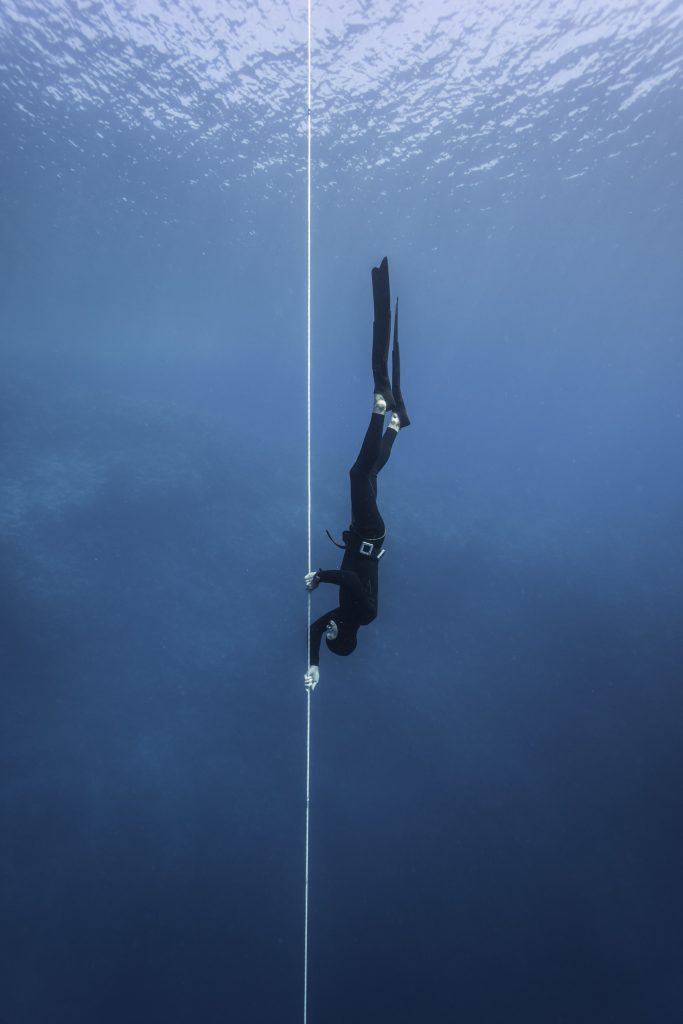
● Profiles of top freedivers and their personal records
Freediving is a sport that attracts some of the world’s most accomplished and talented athletes, who push the boundaries of what is possible in the sport. Here are some profiles of top freedivers and their personal records:
- Herbert Nitsch: Also known as “The Deepest Man on Earth,” Herbert Nitsch is an Austrian freediver who holds the world record for the deepest free dive ever achieved, at a depth of 214 meters (702 feet) in 2007. He also holds the record for the most number of no-limits dives deeper than 100 meters.
- William Trubridge: A New Zealand freediver, William Trubridge holds the world record for the deepest constant weight dive, at a depth of 121 meters (397 feet) in 2016. He also holds the record for the most number of unassisted dives deeper than 100 meters.
- Alexey Molchanov: A Russian freediver, Alexey Molchanov holds the world record for the deepest free immersion dive, at a depth of 125 meters (410 feet) in 2019. He is also the son of the late Natalia Molchanova, who was considered the best female freediver of all time.
- Tanya Streeter: A British freediver, Tanya Streeter holds the world record for the deepest constant weight dive by a woman, at a depth of 160 meters (525 feet) in 2002. She also holds the record for the most number of dives deeper than 100 meters by a woman.
- Natalia Molchanova: Russian Freediver Natalia Molchanova holds the world record for the deepest freedive ever achieved by a woman, at a depth of 101 meters (331 feet) in 2007. She also holds the record for the most number of dives deeper than 100 meters by a woman.
These are just a few examples of the many accomplished and talented freedivers who have pushed the boundaries of the sport and achieved remarkable personal records. They are true inspiration to many and continue to push the limits of human endurance in the underwater world.
● Analysis of the physical and mental challenges faced by these divers
Freediving is a sport that requires a unique combination of physical and mental strength, which can be challenging for even the most accomplished and experienced divers.
One of the biggest physical challenges in freediving is the ability to hold your breath for extended periods of time. This requires a high level of lung capacity, as well as the ability to control your breathing and heart rate. Divers also need to have a good level of cardiovascular fitness, as well as strong and flexible muscles, to be able to hold their body position and move efficiently underwater.
Another physical challenge that divers face is the pressure of the water, which can be intense at deep depths. This can put a lot of strain on the body, especially on the lungs, ears and sinuses. Divers need to train their bodies to be able to handle the pressure, and to be able to equalize correctly to avoid injury.
Mentally, freediving can be a challenging sport due to the need to overcome the natural fear of being underwater. Divers need to be able to control their thoughts and emotions, and to stay calm and focused, even in difficult situations. They also need to be able to manage their time and air efficiently, and to make quick and accurate decisions when diving.
Another mental challenge that divers face is the risk of blackout, which is a loss of consciousness due to lack of oxygen. Divers need to be able to recognize the warning signs of blackout and to know how to prevent it from happening. They also need to be able to deal with the psychological stress and pressure that comes with the sport.
Overall, freediving is a challenging and demanding sport that requires a combination of physical and mental strength and endurance. It requires a lot of preparation and training, and the ability to manage the unique demands of the underwater environment.
IV. Advancements in Freediving Equipment and Technology
● Discussion of the latest equipment and technology used in freediving
The world of freediving is constantly evolving, and with it, the equipment and technology used by divers. In recent years, there have been many advancements that have helped to improve the safety and performance of divers.
One of the most important pieces of equipment for freedivers is the wetsuit. Modern wetsuits are made from neoprene, a type of synthetic rubber that is designed to insulate the body and keep the diver warm. Wetsuits have also been designed to be more flexible, which allows divers to move more freely underwater.
Another important piece of equipment for freedivers is the fins. Freediving fins are designed to be long and slender, which allows divers to move more efficiently through the water. They are also designed to be more flexible, which helps to reduce the strain on the diver’s legs.
A modern freediving computer is another important piece of equipment for divers. These computers are designed to monitor the diver’s depth, time, and remaining air, and also to alert the diver if they are approaching a dangerous depth or running out of air. They also often include a dive planner feature that allows the diver to set a maximum depth and time, and to track their progress.
Another recent innovation in freediving technology is the use of rebreathers. Rebreathers are a type of diving equipment that allows the diver to recycle their exhaled air and to use it again. This allows the diver to stay underwater for longer periods of time, and to breathe more efficiently.
Overall, the latest equipment and technology used in freediving have helped to improve the safety and performance of divers. They have also helped to make the sport more accessible to a wider range of people, allowing them to explore the underwater world in new and exciting ways.
● Analysis of how these advancements have contributed to the evolution of the sport
The advancements in equipment and technology used in freediving have greatly contributed to the evolution of the sport. These innovations have allowed divers to push their limits and reach new depths, and to do so in a safer and more efficient way.
One of the most significant advancements in freediving has been the development of wetsuits. Modern wetsuits are designed to keep the diver warm, which allows them to stay underwater for longer periods of time. The increased flexibility of these wetsuits also allows divers to move more freely, which helps to improve their performance.
Freediving fins have also undergone significant changes over the years, with modern fins being designed to be more efficient and easier to use. This has helped to improve the performance of divers and has also helped to reduce the strain on the diver’s legs.
Rebreathers, which recycle the diver’s exhaled air, have also played a significant role in the evolution of the sport. They allow divers to stay underwater for longer periods of time, and to breathe more efficiently. This has helped to increase the safety of the sport and has also allowed divers to reach new depths.
The use of freediving computers has also been a major contributor to the evolution of the sport. These devices allow divers to monitor their depth, time, and remaining air, and also to alert the diver if they are approaching a dangerous depth or running out of air. The dive planner feature, which allows the diver to set a maximum depth and time, and to track their progress, has also helped divers to achieve their goals in a safer and more efficient way.
Overall, the advancements in equipment and technology have greatly contributed to the evolution of the sport of freediving. They have allowed divers to push their limits, reach new depths, and do so in a safer and more efficient way. With ongoing technological advancements, the sport will continue to evolve and divers will be able to reach even greater depths and achieve even more impressive records.
V. Freediving Disciplines and Records
● Overview of the different disciplines of freediving and the records set in each
Freediving is a sport that involves diving underwater without the use of breathing apparatus. There are several different disciplines within the sport, each with its own set of rules and records.
One of the most popular disciplines is called “Static Apnea,” which involves holding one’s breath underwater for as long as possible. The current world record for this discipline is 11 minutes and 54 seconds.
Another discipline, called “Dynamic Apnea,” involves swimming underwater for as far as possible while holding one’s breath. The current world record for this discipline is 253.5 meters.
“Constant Weight Apnea” is another discipline, in which the diver descends and ascends using only their own muscle power and fins. The current world record for this discipline is 124 meters.
“Free Immersion Apnea” is a discipline where the diver descends and ascends using a rope, but no fins. The current world record for this discipline is 121 meters.
“Variable Weight Apnea” is a discipline where the diver descends and ascends using a weighted sled or lift bag. The current world record for this discipline is -214 meters.
“No-Limits Apnea” is a discipline where the diver descends and ascends using any means, including a weighted sled and inflatable lift bag. The current world record for this discipline is -214 meters.
In addition to these disciplines, there are also records for freediving with fins, and for diving to depths of 100m, 80m, 60m and 40m.
All of these disciplines push the limits of human endurance and test the physical and mental capabilities of the divers. The records set in each discipline are a testament to the dedication and skill of the divers who have achieved them, and are a source of inspiration for others in the sport.
● Analysis of the unique challenges and techniques of each discipline
Each discipline of freediving poses its own unique challenges and requires different techniques to be mastered.
In “Static Apnea,” the challenge is to hold one’s breath underwater for as long as possible. This requires the diver to have a high lung capacity and strong mental focus, as well as the ability to control their breathing and heart rate. Techniques that can be used to increase the time spent underwater include hyperventilation, which increases the amount of oxygen in the lungs, and the “relaxation response,” which helps to slow down the heart rate.
“Dynamic Apnea” involves swimming underwater for as far as possible while holding one’s breath. This requires the diver to have a high level of cardiovascular fitness, as well as the ability to control their buoyancy and streamline their body for maximum efficiency. Techniques that can be used to increase distance include the use of fins, which provide propulsion, and the “dolphin kick,” which is a powerful and efficient swimming technique.
“Constant Weight Apnea” requires the diver to descend and ascend using only their own muscle power and fins. This discipline requires a high level of physical fitness and the ability to control their buoyancy. Techniques that can be used to improve performance include the use of a “downward spiral” or “S-shape” diving technique, which allows the diver to descend quickly while maintaining control, and the use of a “frog kick” or “flutter kick,” which provides propulsion.
“Free Immersion Apnea” is a discipline in which the diver descends and ascends using a rope, but no fins. This requires the diver to be proficient in rope-climbing techniques and to have a high level of upper body strength and endurance.
“Variable Weight Apnea” involves the use of a weighted sled or lift bag, which allows the diver to descend quickly and reach greater depths. This discipline requires the diver to be skilled in the use of the equipment, and to have a good understanding of the effects of pressure on the body at depth.
“No-Limits Apnea” is the most extreme discipline, in which the diver descends and ascends using any means, including a weighted sled and inflatable lift bag. This requires the diver to be highly skilled in the use of the equipment, and to have a deep understanding of the effects of pressure and buoyancy on the body at depth.
All of these disciplines require a high level of skill, dedication, and training to master. In addition to the physical requirements, freedivers must also have a high level of mental focus and the ability to manage their body and mind under extreme conditions.
VI. Freediving and Ocean Conservation
● Impact of freediving on ocean conservation and marine life
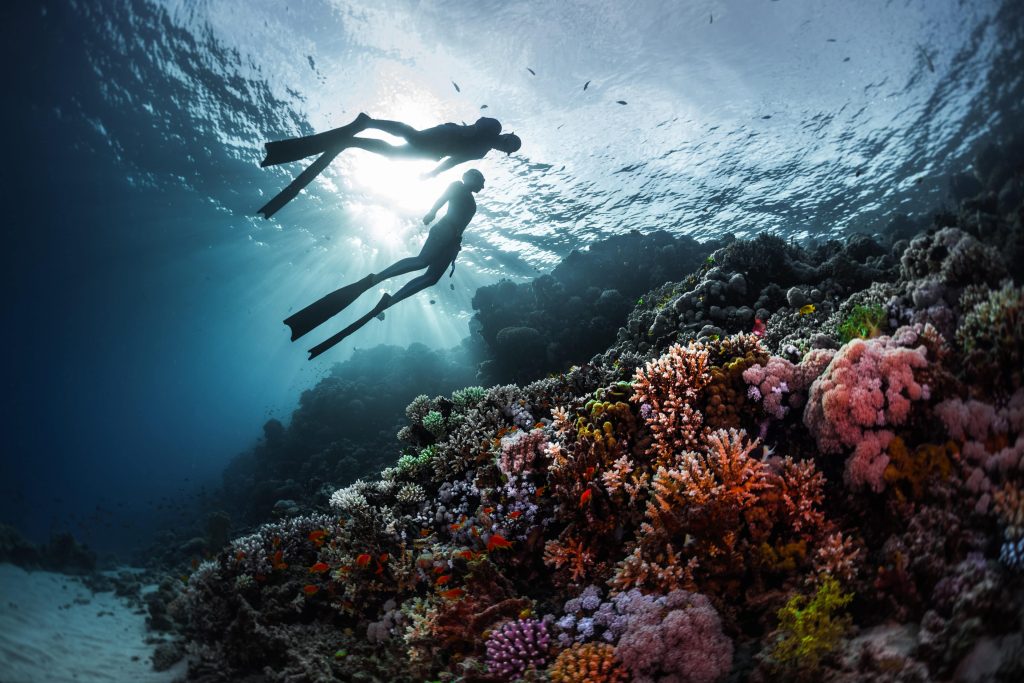
Freediving has a significant impact on ocean conservation and marine life. As a sport, freediving encourages people to explore and appreciate the ocean and its inhabitants. This in turn can lead to a greater awareness and understanding of the need to protect marine environments and the creatures that live within them.
Freediving also has a direct impact on marine life through the actions of divers. Freedivers often encounter marine animals while diving and have the opportunity to observe them in their natural habitats. This can lead to a greater understanding and appreciation of these animals, and can inspire divers to take action to protect them.
Furthermore, freediving can be used as a tool for marine conservation research. Freedivers are able to access areas of the ocean that are difficult or impossible for scuba divers to reach, such as shallow coral reefs or kelp forests. This allows for the collection of valuable data on marine life and habitats that can be used to inform conservation efforts.
However, it’s important to note that freediving also have negative impact on marine life if not done properly. For example, if divers do not follow proper guidelines for approaching marine animals, they can inadvertently disrupt their behavior or harm them. In addition, freediving can also contribute to coral damage if divers do not take appropriate care when diving on reefs.
To minimize the negative impact on marine life, it’s important for freedivers to be aware of and follow established guidelines for responsible diving. This includes being cautious when approaching marine animals, avoiding contact with coral and other delicate habitats, and respecting marine protected areas.
In summary, while freediving can have a positive impact on ocean conservation and marine life, it is important for divers to be aware of and take steps to minimize any negative impact.
● Discussion of how the sport can be used to raise awareness about ocean conservation
Freediving can be a powerful tool for raising awareness about ocean conservation. As a sport that takes place in the ocean, freediving provides a unique perspective on the beauty and fragility of marine environments. This can inspire individuals who participate in the sport to take action to protect the ocean and its inhabitants.
Freediving competitions and events can also be used to raise awareness about ocean conservation. Many competitions and events include educational components that highlight the importance of protecting marine environments and the creatures that live within them. Additionally, the use of freediving as a tool for marine conservation research can also raise awareness about the state of the ocean and the challenges it faces.
Freedivers themselves can also use their platform to raise awareness about ocean conservation. Many top freedivers are active ambassadors for ocean conservation and use their social media and public speaking platforms to share their experiences and encourage others to take action.
However, it’s important to note that not all freedivers are aware of the impact their sport may have on ocean conservation and marine life. Therefore, it’s important for the freediving community to actively promote and educate about ocean conservation, to ensure all divers are informed and aware of the impact their sport can have.
In summary, freediving can be a powerful tool for raising awareness about ocean conservation. From the unique perspectives it provides, to the educational opportunities it offers, to the platform it gives to individuals, the sport can inspire individuals and communities to take action to protect the ocean and its inhabitants.
VII. Tips and Guidelines for Beginners
● Resources for finding training and certification programs
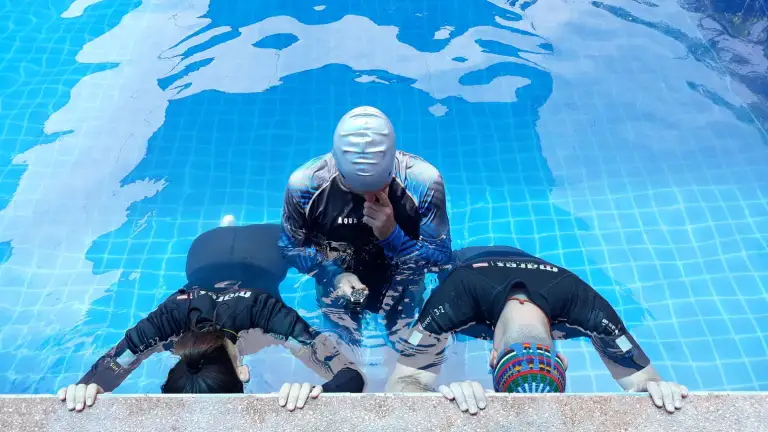
When it comes to finding training and certification programs for freediving, there are a variety of resources available. One of the best places to start is with organizations that specialize in freediving education and certification.
AIDA International, SSI Freediving and PADI Freediving are among the largest and most well-known organizations that offer freediving training and certification. These organizations offer a range of courses and programs, from beginner courses to advanced training, and can certify individuals at different levels. They also have a network of instructors and facilities worldwide.
Another great resource for finding training and certification programs is through local dive shops or water sports centers. Many of these facilities offer freediving courses and training, and can connect individuals with certified instructors in their area.
Online resources such as Dive Training Magazine, Dive Into Freediving, and FreedivingInstructors.com also provide a wealth of information about freediving training and certification programs. They offer a directory of certified instructors and training facilities, as well as articles and resources to help individuals learn more about the sport and find the right training program for them.
Many of these organizations also have a directory of certified instructors and training facilities that can be filtered by location, level of training, price, and more. The use of these resources can help individuals find the right training program for them, whether they are just starting out or looking to advance their skills.
It’s important to note that when choosing a training program, it’s crucial to choose an instructor and organization that is reputable, certified and has a history of providing quality training.
In summary, there are many resources available for finding training and certification programs for freediving. Organizations that specialize in freediving education and certification, local dive shops, water sports centers, and online resources are all great places to start. It’s important to choose an instructor and organization that is reputable, certified, and has a history of providing quality training.
● Discussion of safety measures and protocols followed in the sport
Freediving is a sport that requires a high level of skill and discipline, and safety is of the utmost importance. There are a number of safety measures and protocols that are followed to ensure the well-being of freedivers.
One of the most important safety measures is proper training and certification. Before attempting any dives, it is essential for individuals to receive proper training and certification from a reputable organization such as AIDA International, SSI Freediving, or PADI Freediving. These organizations have a set of standards and protocols that certified instructors must follow to ensure the safety of their students.
Another important safety measure is the use of dive buddies. Freediving is not a solo sport, and it is essential for divers to have a dive buddy or a safety diver to watch over them during their dives. This person is responsible for keeping an eye on the diver and being ready to assist if necessary.
Another important aspect of safety is the use of appropriate equipment. Freedivers need to have the right equipment to ensure their safety, such as fins, mask, wetsuit and weight belt. Properly fitting and maintained equipment is crucial for safety and comfort while diving.
Additionally, it’s important to follow proper dive planning and execution. This includes setting realistic dive goals, monitoring weather and water conditions, and conducting thorough dive site assessments. It also includes proper execution of dive plans, such as proper weighting, proper breathing, and proper descent and ascent.
Finally, it’s important for freedivers to know the signs of hypoxia, hyperventilation, and blackout, and how to deal with them. Hypoxia, hyperventilation and blackout can occur while freediving and they are a serious risk to the safety of the diver. Knowing how to recognize and respond to these conditions is crucial.
In conclusion, safety is of the utmost importance in the sport of freediving. It’s important to have proper training, certification, dive buddies, equipment and dive planning. Additionally, it’s important to know the signs of hypoxia, hyperventilation and blackout and how to deal with them. By following these safety measures and protocols, freedivers can enjoy the sport safely and responsibly.